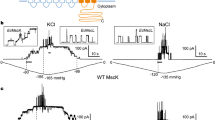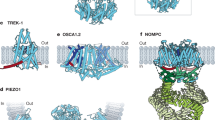Abstract
Cystic fibrosis transmembrane conductance regulator (CFTR) is an anion and intracellular ligand-gated channel associated with cystic fibrosis, a lethal genetic disorder common among Caucasians1. Here we show that CFTR is robustly activated by membrane stretch induced by negative pressures as small as 5 mmHg at the single-channel, cellular and tissue levels. Stretch increased the product of the number of channels present and probability of being open (NPo), and also increased the unitary conductance of CFTR in cell-attached membrane patches. CFTR stretch-mediated activation appears to be an intrinsic property independent of cytosolic factors and kinase signalling. CFTR stretch-mediated activation resulted in chloride transport in Calu-3 human airway epithelial cells and mouse intestinal tissues. Our study has revealed an unexpected function of CFTR in mechanosensing, in addition to its roles as a ligand-gated anion channel1 and a regulator of other membrane transporters2, demonstrating for the first time a mechanosensitive anion channel with a clearly defined molecular identity. Given that CFTR is often found in mechanically dynamic environments, its mechanosensitivity has important physiological implications in epithelial ion transport and cell volume regulation in vivo.
This is a preview of subscription content, access via your institution
Access options
Subscribe to this journal
Receive 12 print issues and online access
$209.00 per year
only $17.42 per issue
Buy this article
- Purchase on Springer Link
- Instant access to full article PDF
Prices may be subject to local taxes which are calculated during checkout





Similar content being viewed by others
Change history
09 July 2010
In the version of this letter initially published online, Fig. 4e–j were incorrectly labelled. This error has been corrected in both the HTML and PDF versions of the letter.
09 June 2010
In the version of this letter initially published online, Fig. 1b and Fig 5e were incorrectly labelled. This error has been corrected in both the HTML and PDF versions of the letter.
References
Gadsby, D. C. & Nairn, A. C. Control of CFTR channel gating by phosphorylation and nucleotide hydrolysis. Physiol. Rev. 79, S77–107 (1999).
Schwiebert, E. M., Benos, D. J., Egan, M. E., Stutts, M. J. & Guggino, W. B. CFTR is a conductance regulator as well as a chloride channel. Physiol. Rev. 79, S145–166 (1999).
Haws, C., Finkbeiner, W. E., Widdicombe, J. H. & Wine, J. J. CFTR in Calu-3 human airway cells: channel properties and role in cAMP-activated Cl- conductance. Am. J. Physiol. 266, L502–512 (1994).
Huang, P. et al. Compartmentalized autocrine signaling to cystic fibrosis transmembrane conductance regulator at the apical membrane of airway epithelial cells. Proc. Natl Acad. Sci. USA 98, 14120–14125 (2001).
Haws, C., Krouse, M. E., Xia, Y., Gruenert, D. C. & Wine, J. J. CFTR channels in immortalized human airway cells. Am. J. Physiol. 263, L692–707 (1992).
Fischer, H., Illek, B. & Machen, T. E. Regulation of CFTR by protein phosphatase 2B and protein kinase C. Pflugers Arch. 436, 175–181 (1998).
Fischer, H. & Machen, T. E. CFTR displays voltage dependence and two gating modes during stimulation. J. Gen Physiol. 104, 541–566 (1994).
Chang, W. & Loretz, C. A. Activation by membrane stretch and depolarization of an epithelial monovalent cation channel from teleost intestine. J. Exp. Biol. 169, 87–104 (1992).
Yao, X., Kwan, H. & Huang, Y. Stretch-sensitive switching among different channel sublevels of an endothelial cation channel. Biochi. Biophys. Acta 1511, 381–390 (2001).
Barnes, A. P. et al. Phosphodiesterase 4D forms a cAMP diffusion barrier at the apical membrane of the airway epithelium. J. Biol. Chem. 280, 7997–8003 (2005).
Huang, P., Trotter, K., Boucher, R. C., Milgram, S. L. & Stutts, M. J. PKA holoenzyme is functionally coupled to CFTR by AKAPs. Am. J. Physiol. Cell Physiol. 278, C417–422 (2000).
Bompadre, S. G., Li, M. & Hwang, T. C. Mechanism of G551D-CFTR (cystic fibrosis transmembrane conductance regulator) potentiation by a high affinity ATP analog. J. Biol. Chem. 283, 5364–5369 (2008).
Hwang, T. C. & Sheppard, D. N. Gating of the CFTR Cl- channel by ATP-driven nucleotide-binding domain dimerisation. J. Physiol. 587, 2151–2161 (2009).
Morris, C. E. & Sigurdson, W. J. Stretch-inactivated ion channels coexist with stretch-activated ion channels. Science 243, 807–809 (1989).
Wan, X., Juranka, P. & Morris, C. E. Activation of mechanosensitive currents in traumatized membrane. Am. J. Physiol. 276, C318–327 (1999).
Small, D. L. & Morris, C. E. Delayed activation of single mechanosensitive channels in Lymnaea neurons. Am. J. Physiol. 267, C598–606 (1994).
Azizi, F., Matsumoto, P. S., Wu, D. X. & Widdicombe, J. H. Effects of hydrostatic pressure on permeability of airway epithelium. Exp. Lung Res. 23, 257–267 (1997).
Kondo, M., Finkbeiner, W. E. & Widdicombe, J. H. Changes in permeability of dog tracheal epithelium in response to hydrostatic pressure. Am. J. Physiol. 262, L176–182 (1992).
Clarke, L. L. A guide to Ussing chamber studies of mouse intestine. Am. J. Physiol. Gastrointest. Liver Physiol. 296, G1151–1166 (2009).
Clarke, L. L. & Harline, M. C. CFTR is required for cAMP inhibition of intestinal Na+ absorption in a cystic fibrosis mouse model. Am. J. Physiol. 270, G259–267 (1996).
Schultz, B. D., Singh, A. K., Devor, D. C. & Bridges, R. J. Pharmacology of CFTR chloride channel activity. Physiol. Rev. 79, S109–144 (1999).
Flynn, A. N., Itani, O. A., Moninger, T. O. & Welsh, M. J. Acute regulation of tight junction ion selectivity in human airway epithelia. Proc. Natl Acad. Sci. USA 106, 3591–3596 (2009).
Button, B. & Boucher, R. C. Role of mechanical stress in regulating airway surface hydration and mucus clearance rates. Respir. Physiol. Neurobiol. 163, 189–201 (2008).
Fan, H. C., Zhang, X. & McNaughton, P. A. Activation of the TRPV4 ion channel is enhanced by phosphorylation. J. Biol. Chem. 284, 27884–27891 (2009).
Hamill, O. P. & Martinac, B. Molecular basis of mechanotransduction in living cells. Physiol. Rev. 81, 685–740 (2001).
van Doorninck, J. H. et al. A mouse model for the cystic fibrosis delta F508 mutation. EMBO J. 14, 4403–4411 (1995).
Clarke, L. L. et al. Defective epithelial chloride transport in a gene-targeted mouse model of cystic fibrosis. Science 257, 1125–1128 (1992).
Sukharev, S. & Anishkin, A. Mechanosensitive channels: what can we learn from 'simple' model systems? Trends Neurosci. 27, 345–351 (2004).
Hale, T. Exercise Physiology; A Thematic Approach. (Wiley, New York; 2004).
Muhm, J. M. et al. Effect of aircraft-cabin altitude on passenger discomfort. N. Engl. J. Med. 357, 18–27 (2007).
Furst, J. et al. Molecular and functional aspects of anionic channels activated during regulatory volume decrease in mammalian cells. Pflugers Arch. 444, 1–25 (2002).
Sardini, A. et al. Cell volume regulation and swelling-activated chloride channels. Biochim. Biophys. Acta 1618, 153–162 (2003).
Valverde, M. A. et al. Impaired cell volume regulation in intestinal crypt epithelia of cystic fibrosis mice. Proc. Natl Acad. Sci. USA 92, 9038–9041 (1995).
Barriere, H. et al. CFTR null mutation altered cAMP-sensitive and swelling-activated Cl- currents in primary cultures of mouse nephron. Am. J. Physiol. 284, F796–811 (2003).
Vazquez, E., Nobles, M. & Valverde, M. A. Defective regulatory volume decrease in human cystic fibrosis tracheal cells because of altered regulation of intermediate conductance Ca2+-dependent potassium channels. Proc. Natl Acad. Sci. USA 98, 5329–5334 (2001).
Valverde, M. A. et al. Murine CFTR channel and its role in regulatory volume decrease of small intestine crypts. Cell Physiol. Biochem 10, 321–328 (2000).
Belfodil, R. et al. CFTR-dependent and -independent swelling-activated K+ currents in primary cultures of mouse nephron. Am. J. Physiol. 284, F812–828 (2003).
Wang, Y. et al. Regulation of CFTR channels by HCO(3)--sensitive soluble adenylyl cyclase in human airway epithelial cells. Am. J. Physiol. Cell Physiol. 289, C1145–1151 (2005).
Wang, D., Sun, Y., Zhang, W. & Huang, P. Apical adenosine regulates basolateral Ca2+-activated potassium channels in human airway Calu-3 epithelial cells. Am. J. Physiol. Cell Physiol. 294, C1443–1453 (2008).
Snouwaert, J. N. et al. An animal model for cystic fibrosis made by gene targeting. Science 257, 1083–1088 (1992).
Acknowledgements
We thank R. Madhavan for stimulating discussion, J.M. Stutts for critical reading of the manuscript and Changyan Xie for assistance in manuscript preparation. This work was supported by the Hong Kong Research Grants Council grant GRF661009 (to P.H.).
Author information
Authors and Affiliations
Contributions
W.K.Z, D.W. and P.H. conceived the study and P.H. directed the study; W.K.Z performed and analysed most of the patch-clamp work with some help from D.W.; D.W. performed and analysed most of the Ussing chamber work with some help from W.K.Z and D.Y.; M.M.T.L designed the Ussing chamber adapted for pressure applications; H.C.C. provided Cftr knockout mice, critical comments and revision of the manuscript; P.H., W.K.Z. and D.W. drafted the manuscript; and P.H. revised the manuscript with contributions from all the authors.
Corresponding author
Ethics declarations
Competing interests
The authors declare no competing financial interests.
Supplementary information
Supplementary Information
Supplementary Information (PDF 692 kb)
Rights and permissions
About this article
Cite this article
Zhang, W., Wang, D., Duan, Y. et al. Mechanosensitive gating of CFTR. Nat Cell Biol 12, 507–512 (2010). https://doi.org/10.1038/ncb2053
Received:
Accepted:
Published:
Issue Date:
DOI: https://doi.org/10.1038/ncb2053
This article is cited by
-
Structure, kinetic properties and biological function of mechanosensitive Piezo channels
Cell & Bioscience (2021)
-
Measurements of spontaneous CFTR-mediated ion transport without acute channel activation in airway epithelial cultures after modulator exposure
Scientific Reports (2021)
-
A microphysiological model of the bronchial airways reveals the interplay of mechanical and biochemical signals in bronchospasm
Nature Biomedical Engineering (2019)
-
Expression of Cystic Fibrosis Transmembrane Conductance Regulator in Ganglia of Human Gastrointestinal Tract
Scientific Reports (2016)
-
The extracellular calcium-sensing receptor regulates human fetal lung development via CFTR
Scientific Reports (2016)



